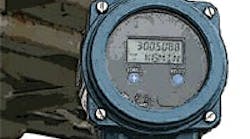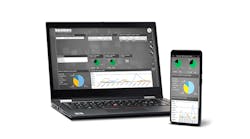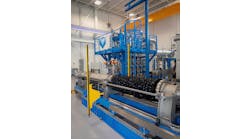By Larell Palmer and Erik Schroeppel
The Eli Lilly and Co. (www.lilly.com) processing plant in Clinton, Ind., uses a fermentation-based process to produce animal health products. Solvent is recovered from the fermentation medium and reused in the production process, providing environmental benefits as well as raw material cost savings.
Three recovery columns distill the fermentation medium to recover the 1% to 2% of solvent it contains. Vaporized solvent is condensed to provide a very pure liquid for recycling. Maintaining high efficiency and speed of separation requires precise control of the temperatures, pressures and flows of components along the column.
The separators also are very important to the overall process mass balance. Inefficient operation can lead to energy waste, output-product-purity problems and poor yield.
The solvent recovery process is continuous and runs year- round. The flow rate into each column is roughly 300 liters/minute. This amounts to 125 million liters/year per column, which requires extracting around 6 million liters/year of solvent from each column. The uptime of each column has been around 80% due to maintenance, upsets and planned downtime.
Drivers for Change
Companies like Lilly now expect a lot more from process control and instrumentation than in the past. We're continually looking to minimize waste, maximize output and optimize efficiency throughout the plant. There's much more focus on the accuracy and reliability of measurements. With the solvent recovery columns, we needed to upgrade the instruments to provide greater accuracy and reliability.
The existing differential pressure/orifice flowmeters, which measure feed, overhead and bottom flows of the separator columns, were around 25 years old and had reached the end of their useful lives. In fact, we actually had stopped performing time-consuming maintenance on these devices. When first installed, they had provided adequate flow measurements that even now would be good enough for inventory management. However, they no longer were giving the accuracy or reliability required for the recovery process.
As a result, much of the operation of the columns became manual. Columns were put in recycle mode due to more frequent process upsets. Lost uptime was estimated to cost an average of $3,000 per upset.
Once or twice a month, the feed flow measurements were so poor that we experienced excursions outside of the control limits. These excursions could be very costly, requiring isolation of the waste streams and further testing/treatment, as well as disruption of other plant processes. We estimated the cost to be as high as $50,000 per upset.
Even without these excursions, we knew the instruments were losing the plant money every day. The lack of optimized control due to inaccurate flow measurements was leading to inefficient energy use, lost solvent and added waste-treatment costs.
A Cost-Effective Option
We initially considered magnetic flowmeters because they provide accurate measurement and long-term reliability at the right price. However, they require external power, and no power wiring ran to our separator columns. We estimated the cost to run power to the 50-ft. columns at about $4,000 per column. Coordinating the efforts of separate groups for electrical and instrumentation work also would affect project cost and schedule. With everything factored in, the total cost to run power was prohibitive.
We'd already standardized on Micro Motion Coriolis flowmeters wherever possible throughout Eli Lilly. Around 200 devices are installed at the Clinton plant, mostly working directly on the manufacturing process. We also have some meters reading natural gas flows into the plant. When the availability of the new two-wire device came to our attention, it was an easy choice for the recovery process.
In September 2009, the first Coriolis meter was installed on the feed line of Column 1 during a routine maintenance shutdown. The device was positioned in the "flag" orientation in a vertical section of pipe (Figure 1). Because Coriolis technology doesn't require a long, straight pipe run before or after the device, it was very easy to fit without serious pipe-work reconfiguration. Installation was simple and incredibly smooth. It took just a few minutes to get the meter up and running, and after a couple of calls to the control room to confirm it was performing correctly, we were done.
{sidebra1}The installation cost totaled $3,258, which included electrical and piping contractors' charges. We incurred some additional costs for piping changes not essential for the new meter install because we decided to put the meter at a height that would provide easy ergonomic access rather than 12 feet in the air as was the case with the old meter.
Impressive Results
The Micro Motion two-wire Coriolis device ideally suits continuous process and mass balance applications. The new meter delivers ±0.2% liquid flow and ±0.002 g/cm3 liquid density accuracy. Once the device was in place, we immediately found that feed flow rates were about 100 liters/minute higher than expected. This was far more than we had anticipated and demonstrated the difficulties we had to overcome when controlling the process.
We've also seen a good improvement in the stability of the recovery process. While operators before often were shooting in the dark regarding feed flow rates, they now have a stable starting point from which to make process adjustments. As a result, there were no upsets caused by the feed.
Not needing to move the process into recycle mode also means we no longer waste energy by being in that mode.
Early last September we replaced three of the remaining eight meters for feed, overhead and bottom flows on the three columns. We also planned to swap out the rest by the end of September. The new devices will allow us to perform an accurate mass balance on the separator. The mass balance information will enable us to optimize the process, maximizing solvent recovery while minimizing energy costs. We hope to improve the efficiency of the process by at least 5% if not much more.
An added bonus is that the Coriolis flowmeters have no moving parts and require very little maintenance. We expect that over time this will create more savings and further improve the uptime and efficiency of the recovery process.
[Editor's note: This article originally appeared in Control's sister publication, Chemical Processing, in its October 2010 issue.]
Larell Palmer is a senior instrument engineer for Eli Lilly & Co. in Clinton, Ind. Erik Schroeppel is a process engineer for Eli Lilly & Co . They can be reached at [email protected] and [email protected].




